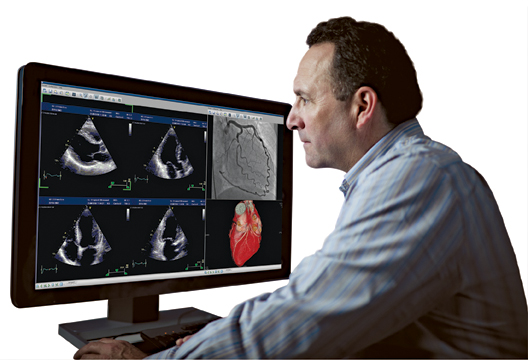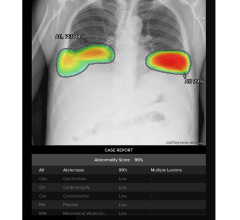
Web-based, single platform cardiac PACS provide the freedom of anywhere access for physicians, as with GE's Centricity Cardio Enterprise.
Healthcare reform requiring wider access and enterprise sharing of patient images and records are making Web-based cardiology picture archiving and communication systems (PACS) a more attractive solution over traditional thick-client, server-based systems. In just the past few years there has been a departure from thick-client cardiology and radiology PACS to Web-based platforms. There are several reasons for this, including better interoperability, anywhere-anytime access, remote access to data and images, and reduction of IT burdens. Web-based systems also enable easier delivery of many healthcare reform Stage 2 meaningful use (MU) requirements.
The biggest clinical benefit of a Web-based cardiology PACS (also referred to as cardiovascular information systems — CVIS) is the ability for cardiologists and supporting staff to conduct their daily duties from one system instead of several disparate systems, each requiring a separate workstation. The single point-of-entry allows access to all cardiac imaging modalities and related reports, echocardiograms (ECG), procedural reports and prior exams from any computer with Web access.
This consolidation of data allows data mining, which can quickly identify the exact numbers and types of cases seen at a facility, numbers and types of tests ordered, patient demographics, how patients are being triaged and treated, and trends in room or equipment usage.
Web-based, single platform cardiac PACS provide the freedom of mobility for cardiologists and referring physicians, regardless of their physical location. This allows new workflows, such as conducting rounds using a tablet device like an iPad rather than a clipboard. The systems allow immediate access to the most up-to-date patient information. Some Web-based systems allow two-way data transfer so physicians can add notes, complete reports, change drug therapy or order additional tests through computerized physician order entry (CPOE) right at the patient’s bedside. Immediate remote access to images, test results and ECGs also has utility in better addressing emergency situations. Just like the cultural revolution Web-based smartphones have created with people’s personal access to the world via the Internet, social media and e-mail, Web-based PACS untether physicians from their desktop computers and allow them to do their job just as well from a remote clinic or at home.
Numerous cardiac PACS vendors released completely re-engineered versions of their systems at American College of Cardiology (ACC) meetings in 2012 and 2013. GE Healthcare, Agfa, Lumedx and Philips launched brand new Web-based platforms. Siemens, McKesson and Infinitt also released several enhancements and new modules for their Web-based systems. Vendors say their new platforms will allow easier integration with both medical device hardware and other software systems by using standards-based architecture with unmodified HL7 and DICOM standards. While partly in response to clinician end-users’ repeated requests for better interoperability over the past decade, the recent improvements and move to Web-based systems is due to the need to meet Stage 2 and eventual Stage 3 MU requirements. Cardiac PACS that do not meet these requirements will eventually face lower reimbursements, and systems that meet the requirements early may qualify for higher reimbursements.
Implementation of Meaningful Use in Cardiology
The latest generation of Web-based cardiovascular PACS offer many cutting-edge technology perks, including software to address Stage 2 meaningful use (MU) requirements. Stage 1 MU requirements were aimed at basic requirements for recording patient data and expanding interoperability of hospital or healthcare system-wide electronic medical records. Stage 2 requirements call for the next level of integration, including specialties such as cardiology and radiology. Stage 2 is designed to expand and leverage IT capabilities to improve efficiency in the U.S. healthcare system.
With the advent of Stage 2, there is an expectation that many hospitals will upgrade or replace their existing cardiovascular PACS to allow better interoperability to meet the new requirements.
While many MU requirements necessitate only small percentages of use in Stage 2, the long-term goal is to expand these capabilities. It is likely that requirements such as CPOE, clinical decision support, remote image and report viewing, physician collaboration, data mining, patient interaction and other requirements will be greatly expanded under Stage 3 requirements in the coming years. Web-based systems will help simplify and facilitate all of the above-mentioned requirements.
Considerations for Web-Based Systems
- Zero-Footprint Access — These systems allow images and data to be accessed anywhere using a Web browser. Some vendors require the download of special software to access the data, while others do not.
- Mobile Devices — There is a growing expectation among physicians to access images and data using their tablet and smart phone devices. By far the largest class of these devices deployed in medicine includes the iPad and iPhone, which use the iOS operating system. Most vendors design access specifically for these devices, but often offer interfaces for other operating systems, such as Android.
- Thick vs. Web-Client — Some systems offer a Web-based and thick-client system, which may differ in functionality.
- Eliminating CDs — A big headache at some facilities is the transfer of files, especially of image datasets on CD between facilities or referring physicians. Burning CDs can be time consuming, and the CDs sometimes cannot be opened or are not compatible with the receiving center’s computers. Web-based systems can help eliminate the need for CDs by allowing direct transfer of the files electronically.
- Creating telecardiology programs may be easier
Comparison chart
This article served as an introduction for the Web-based PACS chart in the July-August 2013 print issue of DAIC. Participants in this chart include:
Agfa Healthcare — www.agfahealthcare.com
Carestream Health — www.carestream.com
Digisonics — www.digisonics.net
DR Systems — www.drsys.com
Fujifilm Medical — cardiovascular.fujimed.com
GE Healthcare — www.gehealthcare.com
Infinitt — www.infinittna.com
McKesson — www.mckesson.com/cardiology
Medstreaming — www.medstreaming.com
Merge Healthcare — www.merge.com
Novarad — www.novacardio.com
Philips Healthcare — www.healthcare.philips.com
ScImage — www.scimage.com


 April 11, 2024
April 11, 2024 








